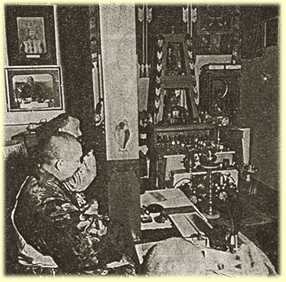 |
The world turmoil at the end of second decade
has produced some brutal uprootings and unusual transplatarions.
From the very beginning of their life in Serbia, the Kalmyks have lived
in a tight community in the same neighborhood and thus maintained close
mutual contact, where virtually everyone knew one another by virtue of
consanguinity, friendship or acquaintance. Joint celebrations of ethnic
and religious holidays, weddings, etc. as well as common mournings at the
funeral and memorial service rites were common denominator in the life
of this unique ethnic group.
Among the Serbs the Temple was known either as'Chinese Church'or 'Buddhist Church'. |
 Shamanism,
a form of religious practice that by definition communes with the ancestral
spirits as well as the spirits of nature and of a specific physical place,
is especially vulnerable to disruption by loss of locale. Hence,
exile from their territories propelled the Kalmyks into an alien world
devoid of familiar homes and kin. It weakened their ability to practice
Buddhism by destroying all their temples and religious artifacts, and separated
them from Shamanism by removal from sacred locale and spirits of these
places - in effect, robbing them of their own ethnic identity and any psychological
means to access it."
Shamanism,
a form of religious practice that by definition communes with the ancestral
spirits as well as the spirits of nature and of a specific physical place,
is especially vulnerable to disruption by loss of locale. Hence,
exile from their territories propelled the Kalmyks into an alien world
devoid of familiar homes and kin. It weakened their ability to practice
Buddhism by destroying all their temples and religious artifacts, and separated
them from Shamanism by removal from sacred locale and spirits of these
places - in effect, robbing them of their own ethnic identity and any psychological
means to access it."